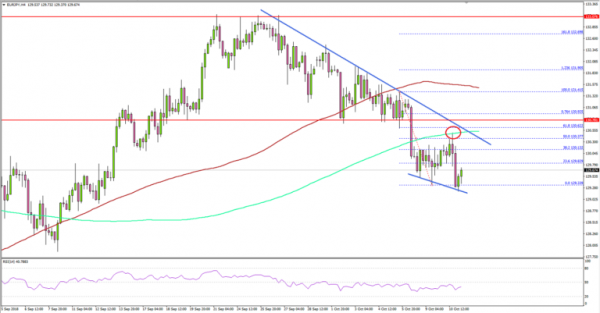Key Highlights
- The Euro declined recently and broke the 130.80 support against the Japanese Yen.
- There is a major bearish trend line in place with resistance at 130.60 on the 4-hours chart of EUR/JPY.
- Recently in Japan, the Machinery New Orders posted a growth of 6.8% in August 2018 (MoM).
- Today, the US Consumer Price Index for Sep 2018 will be released, which is forecasted to increase 0.2% (MoM).
EURJPY Technical Analysis
The Euro made many attempts to break the 133.00 resistance area against the Japanese Yen, but failed. The EUR/JPY pair started a downside move and broke the 132.00 and 131.20 support levels.
Looking at the 4-hours chart, the pair came under bearish pressure after it broke the 130.80 support and the 100 simple moving average (red, 4-hours). The pair even declined below the 130.00 support and traded towards the 129.25 support.
A low was formed at 129.33 and later the pair started an upside correction. The pair traded higher and cleared the 38.2% Fib retracement level of the last drop from the 131.45 high to 129.33 low.
However, there are many hurdles for buyers near the 130.60 and 130.80 resistance levels. There is also a major bearish trend line in place with resistance at 130.60 on the same chart.
Moreover, the 61.8% Fib retracement level of the last drop from the 131.45 high to 129.33 low is near the 130.62 level, which is likely to act as a strong resistance.
Therefore, as long as the pair is below the 130.60 and 130.80 resistance levels, it remains at a risk of more losses in the near term.
On the downside, an initial support is near the 129.50 level, followed by 129.25. Below these two, the EUR/JPY pair is likely to accelerate losses towards the 128.40 level.
Economic Releases to Watch Today
- US Initial Jobless Claims – Forecast 206K, versus 207K previous.
- US Consumer Price Index Sep 2018 (MoM) – Forecast +0.2%, versus +0.2% previous.
- US Consumer Price Index Sep 2018 (YoY) – Forecast +2.4%, versus +2.7% previous.
- US Consumer Price Index Ex Food & Energy Sep 2018 (YoY) – Forecast +2.3%, versus +2.2% previous.












